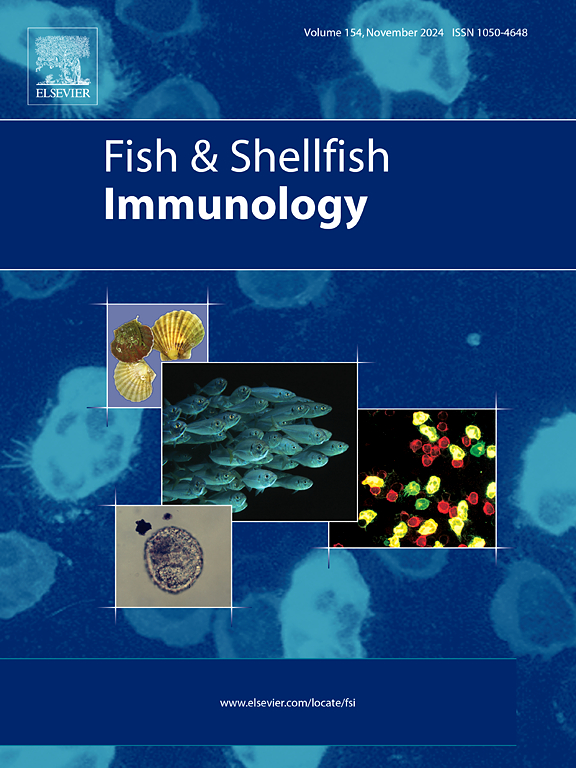嗜水气单胞菌感染的尼罗褐虾饲料中单宁酸的抗炎、免疫刺激和抗菌特性。
IF 4.1
2区 农林科学
Q1 FISHERIES
引用次数: 0
摘要
本研究旨在评估在饮食中添加单宁酸对暴露于嗜水气单胞菌后的尼罗褐口鱼的生长、健康和存活的影响。将320尾鱼分成16个水族箱,分为添加0.2%单宁酸(TA0.2%)、0.4%单宁酸(TA0.4%)、0.8%单宁酸(TA0.8%)和不添加单宁酸(Control0%) 4个处理组,每个处理重复4次,试验期50 d。在50天结束时,从鱼身上收集生物样本,然后向其腹腔注射嗜水单胞杆菌。不同处理间的生长性能无显著差异。正如预期的那样,无论接受何种治疗,感染后鱼血液中的总白细胞、淋巴细胞、单核细胞、血红蛋白和平均红细胞血红蛋白浓度(MCHC)水平均显著升高。在感染前后,TA0.2%和TA0.8%治疗组的单核细胞比TA0.4%治疗组的单核细胞更丰富。此外,影响血小板、中性粒细胞、嗜碱性粒细胞、血红蛋白和MCHC的因素之间存在显著的相互作用。感染前TA0.8%组的血小板增多和中性粒细胞增多明显高于感染后和对照组。相反,与感染前相比,TA0.8%治疗组在感染后观察到更多的嗜碱性粒细胞。无论单宁酸补充水平如何,感染后血浆总蛋白水平显著下降,而免疫球蛋白水平在暴露于嗜水单胞杆菌后升高。组织学分析显示,TA0.4%治疗组感染前肠绒毛周长和数量明显增加。感染前对照组杯状细胞数量增加(0%),TA0.4%和TA0.8%。在脾组织中,TA0.4%治疗导致嗜酸性粒细胞和单核浸润减少,充血和空泡化减少。TA0.4%和TA0.2%治疗组含铁血黄素水平较低。在肝脏,TA0.2%和TA0.4%治疗组淋巴细胞浸润减少,TA0.2%感染后和TA0.4%感染前组门静脉充血减少。TA0.4%治疗组感染后生存率(91%)显著高于TA0.8%治疗组(85%)和对照组(71%),差异有统计学意义(p < 0.05)。本研究结果表明,单宁酸对尼罗罗非鱼的免疫系统有积极作用。血液中先天免疫的改善,以及组织学分析中所见的抗菌和抗炎作用,都支持了这一点。因此,建议在尼罗罗非鱼的饲料中添加0.4%的单宁酸剂量,并进一步研究该食品添加剂对罗非鱼的潜在益处。本文章由计算机程序翻译,如有差异,请以英文原文为准。

Anti-inflammatory, immunostimulant and antimicrobial properties of tannic acid in the diet of Oreochromis niloticus infected with Aeromonas hydrophila
The study aimed to assess the impact of dietary supplementation with tannic acid on the growth, health, and survival of Oreochromis niloticus following exposure to Aeromonas hydrophila. A total of 320 fish were divided into 16 tanks and assigned to four treatment groups: feed with 0.2 % tannic acid (TA0.2 %), 0.4 % tannic acid (TA0.4 %), 0.8 % tannic acid (TA0.8 %), or no tannic acid (Control0%), with each treatment replicated four times, over a 50-day period. At the end of the 50-day period, biological samples were collected from the fish, which were then intraperitoneally injected with A. hydrophila. No significant differences in growth performance were detected between treatments. As expected, levels of total leukocytes, lymphocytes, monocytes, hemoglobin, and mean corpuscular hemoglobin concentration (MCHC) were notably higher in the blood of the fish after infection, regardless of the treatment received. During both the pre- and post-infection periods, monocytes were more abundant in the TA0.2 % and TA0.8 % treatments compared to the TA0.4 % treatment. Additionally, there was a significant interaction between the factors affecting thrombocytes, neutrophils, basophils, hemoglobin, and MCHC. Thrombocytosis and neutrophilia were significantly greater in the TA0.8 % treatment pre-infection than in the post-infection and control group. Conversely, a higher number of basophils were observed in the post-infection period in the TA0.8 % treatment group compared to the pre-infection period. Total plasma protein levels decreased significantly in the post-infection period, regardless of tannic acid supplementation levels, while immunoglobulin levels increased after exposure to A. hydrophila. Histological analyses revealed a significant increase in the perimeter and number of intestinal villi in the TA0.4 % treatment group before infection. The number of goblet cells also increased in the control group (0 %), TA0.4 %, and TA0.8 % before infection. In splenic tissue, the TA0.4 % treatment resulted in a reduction in eosinophilic and mononuclear infiltrates, as well as decreased congestion and vacuolation. Hemosiderin levels were lower in the TA0.4 % and TA0.2 % treatment groups. In the liver, lymphocytic infiltrates were reduced in the TA0.2 % and TA0.4 % treatment groups, and portal vein congestion was decreased in the TA0.2 % post-infection and TA0.4 % pre-infection groups. Post-infection survival rates were significantly higher (p < 0.05) in the TA0.4 % treatment group (91 %) compared to the TA0.8 % treatment group (85 %) and the control group (71 %). The results of the present study show that tannic acid has a positive effect on the immune system of Nile tilapia. This is supported by improvements in innate immunity in the blood, as well as the antimicrobial and anti-inflammatory effects seen in histological analyses. Therefore, it is suggested to use a 0.4 % tannic acid dose for dietary supplementation of Nile tilapia, along with further studies on the potential benefits of this food additive for tilapia.
求助全文
通过发布文献求助,成功后即可免费获取论文全文。
去求助
来源期刊

Fish & shellfish immunology
农林科学-海洋与淡水生物学
CiteScore
7.50
自引率
19.10%
发文量
750
审稿时长
68 days
期刊介绍:
Fish and Shellfish Immunology rapidly publishes high-quality, peer-refereed contributions in the expanding fields of fish and shellfish immunology. It presents studies on the basic mechanisms of both the specific and non-specific defense systems, the cells, tissues, and humoral factors involved, their dependence on environmental and intrinsic factors, response to pathogens, response to vaccination, and applied studies on the development of specific vaccines for use in the aquaculture industry.
 求助内容:
求助内容: 应助结果提醒方式:
应助结果提醒方式:


